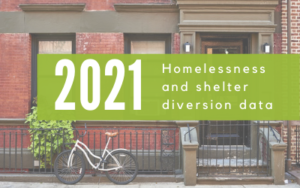Help for Hamilton County Homelessness: 381-SAFE
Discussion Groups › Housing Resource Discussions › Help for Hamilton County Homelessness: 381-SAFE
- This topic has 1 reply, 2 voices, and was last updated 3 years, 7 months ago by
 Strategies to End Homelessness.
Strategies to End Homelessness.
-
AuthorPosts
-
-
May 3, 2022 at 10:32 am #59255
Help for Hamilton County Homelessness: 381-SAFE. Hamilton County Homelessness On The Rise Homelessness is a critical local issue. In 2021, 6,062 people in Hamilton County experienced homelessness, re… End of excerpt, click here for the whole article–> https://cincinnati.unitedresourceconnection.org/help-for-hamilton-county-homelessness/ You must be logged in to comment.
-
May 6, 2022 at 4:08 pm #59256
2021 Cincinnati Homelessness Data
 We’re often asked: “How many people are homeless in Cincinnati? How do you know? The U.S. Department of Housing and Urban Development (HUD) has charged Strategies to End Homelessness with overseeing our local HMIS.
We’re often asked: “How many people are homeless in Cincinnati? How do you know? The U.S. Department of Housing and Urban Development (HUD) has charged Strategies to End Homelessness with overseeing our local HMIS.The data we collect is updated daily and we can check progress with our System Performance Dashboard. Read on for a Snapshot of the 2021 Cincinnati Homelessness Data.
Homelessness Data is Collected in a Single HMIS
The Cincinnati/Hamilton County Continuum of Care was the first in the nation to have all homeless services agencies utilizing a single Homeless Management Information System (HMIS). Strategies to End Homelessness is the lead agency for our local HMIS. All of our partner agencies contribute data into our HMIS system, Clarity HMIS by Bitfocus.
From HMIS, we have complete and accurate data on all program participants. And this gives us immediate access to data to track program outcomes in real time and improve underperforming programs. We also have a data analyst on our staff to closely watch performance measures across the system and to identify trends.
Defining Homelessness
So, before we can talk about data regarding people experiencing homelessness, we must first define what homelessness means. For this purpose, we’ll be explaining data and trends regarding people who: 1) unsheltered, that are sleeping in a place not meant for human habitation (such as on the streets, under a bridge, in a car), 2) residing in an emergency shelter, or 3) are fleeing domestic violence.
Dispelling Myths Through Data
Part of our work is to dispel stereotypes and the myths around homelessness. Picture in your mind our neighbors experiencing homelessness. In Cincinnati/Hamilton County roughly 1 of every 4 people experiencing homelessness is a child. A child under 18.
More than half – 51% – of our homeless population is 35 years old or younger. So that’s very different than the “older man with a substance abuse problem” stereotype we often encounter.
2021 Cincinnati Homelessness Data: People in Emergency Shelter & on the Streets
In 2021:
- 6,062 total unduplicated people on the streets & in shelters, that’s a<1% decrease from 2020 and a 14% decrease since 2019
- 5,603 resided in Emergency Shelter. 92% of total population spent at least part of the year in shelter, that’s a <1% decrease from 2020, a 16% decrease from 2019
- 917 unsheltered on the streets, 15% of total population spent at least part of the year on street, that’s a 10% decrease from 2020; 46% decrease from 2013.
- The national average of unsheltered homelessness is 35% vs. 15% locally.
- 7.5% exclusively sleeping unsheltered on the streets (459 people)
2021 Cincinnati Homelessness Data: Total Homelessness System Data including Housing Programs
Shelter Diversion + Street Outreach + Emergency Shelter + Supportive Housing Programs, Unduplicated
11,364 people served
By Race
Here, locally in Cincinnati/Hamilton County 64% of our homeless population is African American; 30% White/Caucasian; 5% Multiracial; and 1% unknown.
By Gender
Adults by Gender 59% Male, 40% Female, 1% Transgender/no single gender
Children by Gender 48% Male, 52% Female, <1% Transgender/no single gender
Children and Youth Experiencing Homelessness
- 23% of people on streets or in shelter are children, that’s 1,381 children
- 10% between age of 18-24 (598) and 18% between age of 25-34 (1,115)
- 415 families resided in emergency shelter in 2021. And of those, almost one quarter were led by parent aged 18-24.
Our Homeless Population Overall is Young
- Total: 51% of our homeless population is under age 35
Homelessness Prevention: Shelter Diversion Program
Shelter Diversion is one of the best ways to prevent and reduce homelessness. And the most cost effective intervention available. But how does it work?
- 56% of people in the Shelter Diversion program are children; 665 children
2021 Cincinnati Homelessness Data: Other Key Takeaways
- ”Street” / Unsheltered Homelessness: Decreased each year from 2013-2019
- There was a 22% increase in unsheltered homelessness in 2020, followed by a 10% decrease in 2021
- On average, 35% unsheltered nationally vs. 15% locally
- Only 7.5% unsheltered only (no stay in shelter in 2020)
- We experienced reduced capacity in shelters due to COVID-19
- Significant investment was made in improving singles shelters 2012-2015 through the Homeless to Homes Plan
- We saw a 5.8% increase in people in shelter from 2014-2019, corresponding decrease in people on the streets
- People are 3x as likely to die on the street vs. in shelter; more people coming into shelter and fewer unsheltered is positive
Attention media partners and community members
The U.S. Department of Housing and Urban Development (HUD) has charged Strategies to End Homelessness with overseeing our local HMIS. Read more about HUD’s HMIS Requirements. Data published regarding homelessness in Greater Cincinnati, not issued by Strategies to End Homelessness, may be inaccurate or out of date.
Please contact us directly with data requests: sberger@end-homelessness.org.
The post 2021 Cincinnati Homelessness Data appeared first on Strategies to End Homelessness.
-
-
AuthorPosts
- You must be logged in to reply to this topic.


